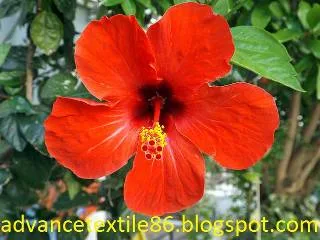Introduction
Kenaf fiber
Kenaf
fiber is one of the most natural fibers used as a reinforcement in polymer
matrix composites. It is also known as Hibiscus cannabinus L. It is an
herbaceous annual plant that grows in a variety of climatic conditions and
grows to more than 3 meters in 3 months. The maximum growth rate can be up to
10 cm/day. However, differences in growth parameters affect the characteristics
of kenaf fibers like the length of the growing season, plant population, and
cultivator, date of planting, photosensitivity, and plant maturity. The stems
of the Kenaf tree are straight and do not branch with the stems. It is made
with bark and a core. Therefore it is easy to separate the stem by chemical or
enzymatic ratings. The bark contributed 30% -40% of the dry weight to the stem
while the wood-like core weighed the rest. It was used to make composite
boards, textiles, pulp, and paper industry.
Best
kenaf fibers have better energy properties than core fibers. So it is more
suitable for high-power applications. One study used Kenaf bast fiber to
compare clay properties with flat concrete in its properties. The results
indicated that the mechanical properties of the concrete compound were
comparable to that of a flat concrete sample. In addition, the concrete
compound has even shown cracking and higher rigidity in distribution. So
concrete composite construction is being claimed as a potential material for
the application.
Properties of Kenaf fiber
i.
Kenaf fiber is one of the famous natural bast fibers.
ii.
It has a strength of 350-600 MPa
iii.
Elastic modulus of kenaf fiber 40,000 MPa
iv.
Elongation at break of kenaf fiber 2.5-3.5 %
v. The density of kenaf fiber 1500 Kg/m3
vi.
Kenaf fiber matures in 100 to 200 days.
Chemical composition of Kenaf fiber
Cellulose
– 63 %
Hemicellulose
– 18 %
Lignin
– 13 %
Extractives
– 4 %
Ash
– 2 %
Kenaf harvesting process
When the hand-cut harvesting process used, the long, cylindrical stalks are cut at or near the ground level on a curved blade or machete is used. Typically, the plants are still actively growing at harvest time, near or already flowering. In most of these places, kenaf trees are usually cut down before a killing frost due to improved maturation of the trees or lack of frost in their places. The hand-applied plants are then prepared for the retreading process.
The retting process usually involves moisture with bacteria or chemicals to remove unwanted bark material from the Kanaf fiber strand. Kenaf is retted by natural processes that primarily use aerobic bacteria, as opposed to mucus water-retting which is primarily carried by anaerobic bacteria and various fungi. The whole stalk kenaf, or simply parts of the bark, are tied into bundles and flowed slowly in ponds, canals, or around the fiber strands of the bark to allow the plant to digest the plant material.
Uses of Kenaf fiber
i.
The main uses of kenaf fiber are rope, yarn, coarse cloth, and paper.
ii.
The use of kenaf fiber includes engineered wood, insulation, clothing-grade
fabrics, soil-less pot mix, animal bed, packing material, and ingredients that
absorb oils and liquids.
iii.
As the best-cut fiber for mixing with resin in making plastic composites, it is
also effective for drilling fluid corrosion-resistant for oil drilling clay, and
seeded hydro-mulch for erosion control.
iv.
The BMW i3 uses Kenaf around the black.
v.
The use of kenaf is expected to offset 300,000 pounds of oil-based resin per
year.
Conclusion
Kenaf's global market has been expanding rapidly over the past several years. Currently, industries are producing more products using Kenaf composites. Comparing a few more fibers with kenaf showed that kenaf fibers are cheaper and have better strength than other natural fibers. Kenaf fibers can be collected using hand harvesting and retting decorticator machines, and whole stalk cutters using three separate methods.










0 Comments